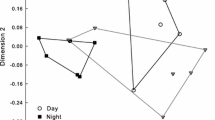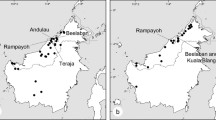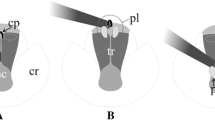Abstract
The flowers of two species ofTernstroemia from Central Amazonia were observed to be pollinated by female bees performing vibrational foraging. The anthers of these flowers are longitudinally dehiscent. They are completely included in a petal tube, which opens by a small pore at the apex. Pollen is expelled out of this pore when the bees vibrate the flower while curling over the apex of the petal tube. The much elongated connectives probably transmit the vibrations from the petals to the anthers. The possible occurrence of this mode of pollination in other species ofTernstroemia is briefly discussed.
Similar content being viewed by others
References
Buchmann, S. L., 1983: Buzz pollination in angiosperms. — InJones, C. E., Little, R. J., (Eds): Handbook of experimental pollination biology, pp. 73–113. — New York, Cincinnati, Toronto, London, Melbourne: Scientific and Academic Editions.
Corner, E. J. H., 1958: Transference of function. — J. Linn. Soc. Bot.56: 33–40.
Gottsberger, G., 1987: Evolution of flower structures and pollination in neotropicalCassia species. — XIV. Intern. Bot. Congr. Berlin, Abstracts: 224.
—,Silberbauer-Gottsberger, I., 1988: Evolution of flower structures and pollination in neotropicalCassiinae (Caesalpiniaceae) species. — Phyton28: 293–320.
Keng, H., 1962: Comparative morphological studies inTheaceae. — Univ. of California Pub. Bot.33: 269–384.
Kobuski, C. E., 1942: Studies in theTheaceae, XIII. Notes on the Mexican and Central American species ofTernstroemia. — J. Arnold Arbor.23: 464–478.
—, 1951: Studies in theTheaceae XXII. Some new species ofTheaceae in South America. — J. Arnold Arbor.32: 152–154.
—, 1961: Studies in theTheaceae XXX. The African species ofTernstroemia. — J. Arnold Arbor.42: 81–86.
Kubitzki, K., Amaral, M. C. E., 1991: Transference of function in the pollination system of theOchnaceae. — Pl. Syst. Evol.177: 77–80.
Lumer, C., 1980: Rodent pollination ofBlakea (Melastomataceae) in a Costa Rican cloud forest. — Brittonia32: 512–517.
Ramirez, N., Gil, C., Hokche, O., Seres, A., Brito, Y., 1990: Biologia floral de una communidad arbustiva tropical en la Guayana Venezolana. — Ann. Missouri Bot. Gard.77: 383–397.
Simpson, B. B., Neff, J. C., 1981: Floral rewards: alternatives to pollen and nectar. — Ann. Missouri Bot. Gard.68: 301–322.
Vogel, S., 1978: Evolutionary shifts from reward to deception in pollen flowers. — InRichards, A., (Ed.): The pollination of flowers by insects, pp. 89–96. — Linn. Soc. Symp. Ser.6: — London: Academic Press.
Wawra Von Fernsee, H., 1886:Ternstroemiaceae. — InMartius, C. F. P., (Ed.): Flora Brasiliensis XII,1: 263–334.
Author information
Authors and Affiliations
Rights and permissions
About this article
Cite this article
Bittrich, V., Amaral, M.C.E. & Melo, G.A.R. Pollination biology ofTernstroemia laevigata andT. dentata (Theaceae). Pl Syst Evol 185, 1–6 (1993). https://doi.org/10.1007/BF00937716
Received:
Revised:
Accepted:
Issue Date:
DOI: https://doi.org/10.1007/BF00937716




